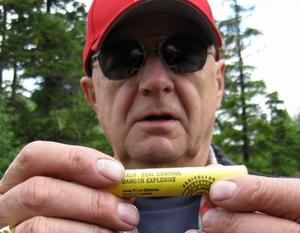ExplosivesATF cracks down on bombs used to scare seals
Much to the frustration of California fishermen, the U.S. Bureau of Alcohol, Tobacco, Firearms, and Explosives (ATF) is starting to regulate the firecrackers used to scare away seals from fishing lines; beginning 1 May, ATF officials will begin enforcing a federal law that mandates anyone who purchases the seal “bombs” to obtain a special permit and clear a background check in order to prevent terrorists or criminals from using them; the bombs resemble M-80 firecrackers and are shot from a gun; fishermen and farmers use them to scare away animals like hungry birds or seals

ATF will regulate firecrackers to prevent use by terrorists // Source: wordpress.com
Much to the frustration of California fishermen, the U.S. Bureau of Alcohol, Tobacco, Firearms, and Explosives (ATF) is starting to regulate the firecrackers used to scare away seals from fishing lines.
Beginning 1 May, ATF officials will begin enforcing a federal law that mandates anyone who purchases the seal “bombs” to obtain a special permit and clear a background check in order to prevent terrorists or criminals from using them.
The bombs are used by fishermen and farmers to scare away animals like hungry birds or seals. For instance many farmers use them to protect their vineyards and other crops, while officials at San Francisco International Airport use them to keep birds from congregating near runways. Landfill owners also use them to keep seagulls away.
The bombs resemble M-80 firecrackers and are shot from a gun. Rather than hurting the animal, these explosives are designed to frighten them away.
ATF considers the seal bombs as “high explosives” because they contain flash powder that could potentially cause a lot of damage if used by a terrorist or criminal.
Helen Dunkel, a spokeswoman with ATF’s San Francisco division, said, “You don’t just let any kid on the street use them.”
“There’s too many opportunities for unlawful users to buy them, and there’s no paper trail for that,” she explained.
According to ATF statistics the animal bombs were used with criminal intent at least eleven times in 2009.
The Safe Explosives Act of 2002 had originally required fishermen and farmers to obtain permits, but sellers were not checking for permits and ATF had not enforced the law.
But, now that ATF is implementing the permit requirement, many farmers and fishermen are grumbling about the lengthy new bureaucratic process to obtain permits.
Diane de Lorimier, the co-owner of Sutton Ag Enterprises, a large distributor of bird bombs in the Bay Area, said there has been a steep decline in her business beginning this month.
“I have a one-page list of people who can now buy from us, and last week I had more than 1,000,” she said.
De Lorimier explained that most farmers have either turned to other methods or are still waiting to get their permits, which requires filling out a five-page application, getting fingerprinted, and waiting for a background check.
“There’s a cost associated with it, so I don’t know if it’s even worth it to me,” Giusti said.
For Bay Area salmon fishermen, the bombs were one of the only tools they had to combat hungry seals and sea lions that would trail their boats eating fish from their lines. Some fishermen estimate that they’ve lost as much as $3,000 a day during the height of salmon season.
But, according to Larry Collins, the president of the San Francisco Crab Boat Owners’ Association, seal bombs are not as popular as they once were as they are not that effective.
Collins explained, “[The seals] swim away, and they swim right back. It’s probably more effective to throw raw potatoes at them.”
